These two are titans in the JS industry so there is no surprise to see Next.js vs react all over the internet. So let’s see what are their strengths and their shortcomings.

NextJS
Next.js is a JavaScript framework that allows you to create server-rendered and statically generated web apps. It is built on top of the popular JavaScript package React and allows developers to rapidly and simply create performant and scalable SSR web apps. As it is built on top of react you can expect a lot of similarities.
Next.js has several characteristics that make it especially well-suited for server-side rendering, such as automatic code splitting, optimized performance, and the ability to build full-fledged web servers with Node.js without the need to create a separate project. It also includes support for popular libraries such as GraphQL, which may be used to retrieve data from APIs or other server-side sources.

React
React, on the other hand, is a JavaScript library (a common misconception). It enables developers to design reusable components that can be rendered on the front end, making it easier to build and manage complicated online applications. Easier to manage but it’s still JavaScript so expect chaos nevertheless
React is mainly concerned with offering a strong and flexible framework for creating user interfaces. Its virtual DOM (Document Object Model) allows developers to easily update the front end, and its reusable components make it simple to design and manage large-scale applications.
Overall, Next.js and React are both powerful tools for building modern web applications and can be used together or separately depending on the needs of a particular project.
Popularity

Looking at the graph (data from Statista.com) we can clearly see that React dominates when it comes to front-end Framework usage (considering NodeJS is backend). However, React has been here much longer than Frameworks such as VueJS or NextJS.
NextJS has gained traction and continues so thanks to its active development and features. Same as VueJS.
History and notable updates

NextJS
The startup Zeit originally published Next.js in October 2016, and it has since become one of the most popular JavaScript frameworks for developing server-rendered and statically-generated web apps. Some significant changes and milestones in the history of Next.js:
- Version 2.0, published in November 2017, included server-side rendering with automated code splitting, as well as the ability to construct full-fledged web servers using Node.js.
- Version 4.0, published in June 2018, included support for automated picture optimization and the ability to construct serverless apps using AWS Lambda.
- Version 10.0, released in June 2020, introduced improved support for hybrid applications that can be rendered both on the server and the client, as well as improved support for API routes.
- Version 13.0, released in October 2022, introduced Turbopack. Turbopack is a new general-purpose JavaScript bundler. Improved layouts, new loading convention, and more

React
React was launched by Facebook in 2013 and has since become one of the most popular JavaScript libraries of all time. Some significant developments and milestones in React’s history:
- In April 2016, version 15.0 was released, which included a new reconciler library that improved efficiency and made it easier to combine React with other libraries.
- Version 16.0, published in September 2017, featured a new core architecture dubbed “Fiber,” which enhanced asynchronous update handling and provided support for error boundaries, which can assist prevent crashes in the case of an error.
- Version 18.0, released in April 2021, added support for concurrent mode, which allows applications to render updates more efficiently and smoothly.
- The current newest version is 18.2, which if you are interested in what it came up with, you can see here
Similarities and differences between NextJS and React

Similarities
- Both technologies are based on JavaScript
- Both technologies are designed to make it easier to build and maintain complex web applications
- Both technologies can be used together in a single application

Differences
- Next.js is a full-featured framework, while React is a library
- Next.js is designed for server-side rendering, while React is designed for client-side rendering
- Next.js provides a more comprehensive set of tools out of the box, while React is more flexible and can be used in a wider range of contexts
- Next.js has built-in support for features like automatic code splitting and serverless deployment, while React does not.
Despite these distinctions, Next.js and React may coexist in a single application, with Next.js managing server-side rendering and React handling client-side rendering. This may be a potent combo, allowing developers to capitalize on the capabilities of both technologies. So why Next.js vs React if you can get NextJS AND React!?
Benefits and Drawbacks | Next.js vs React

Benefits of Next.JS
- Server-side rendering can increase a web application’s speed and SEO.
- Automatic code splitting can assist minimize the initial payload size, making the application load quicker.
- The built-in support for popular libraries such as GraphQL makes it simple to retrieve data from APIs and other server-side sources.
- The ability to create full-fledged web servers using Node.js simplifies the development and deployment of apps.
Cons of Next.JS
- Next.js is opinionated and may not be suitable for all types of projects
- The server-side rendering can add complexity to the development process
- The framework may have a steeper learning curve for developers who are not familiar with server-side rendering
Pros of React
- The virtual DOM allows for efficient updates to the user interface
- Reusable components make it easy to build and maintain large-scale applications
- The flexibility of the library allows it to be used in a wide range of contexts
- Ecosystems of libraries specifically for React
Cons of React
- Client-side rendering can be slower than server-side rendering in some cases
- The library does not provide as many out-of-the-box features as some full-featured frameworks
- Import chaos
What is built with React and what is built with NextJS?
React
NextJS
Conclusion of Next.JS vs React
In conclusion, Next.js and React are both powerful tools for building modern web applications. The main point to consider is: does your project needs SSR? Of course, there are other variables to consider but more often than not this is what it comes down to. That’s why Next.js vs React doesn’t make as much sense as when NextJS and when React. If you just need a simple page with mostly static data then can’t go wrong with React.
Of course, don’t forget about other options like Angular or Vue. React and NextJS are very popular, absolutely but not the only ones.
For developers who are interested in learning more about Next.js and React, there are a number of resources available, including the official documentation (NextJS, React) for each technology and online tutorials and courses. Just search youtube and you will find heaps of great tutorials for both.
Additionally, there are active communities of developers who are using these technologies, and participating in online forums or meetups can be a great way to learn more and get support.
Thank you for reading!



